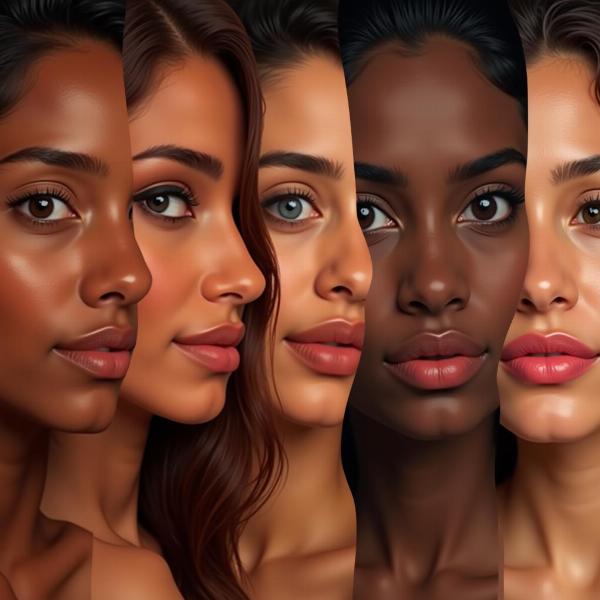Dusky complexion meaning in Hindi often involves navigating a nuanced cultural landscape. While a direct translation might suggest words like “saanvala” (dark-complexioned) or “gora” (fair-complexioned), the meaning goes much deeper, reflecting societal perceptions and traditional beliefs. This article explores the various terms used to describe dusky complexion in Hindi, their cultural context, and the evolving understanding of beauty in India.
Decoding “Dusky” in the Indian Context
In India, “dusky” isn’t just a descriptor of skin color; it’s a term laden with cultural baggage. Historically, fairer skin was associated with higher social status, leading to a preference for “gora” complexion. This preference is rooted in ancient caste systems and colonial influences. However, in recent years, there’s been a significant shift in this perception. The celebration of dusky beauty is becoming increasingly prevalent, challenging traditional beauty standards. What does dusky complexion mean in Hindi today? It’s starting to represent beauty, strength, and pride in one’s natural skin tone.
Common Hindi Terms for Dusky Complexion
Several Hindi words capture the shades and nuances of dusky skin tones:
- Saanvala/Saanvli (saan-va-la/saan-vli): This is perhaps the most common and respectful term for someone with a dusky complexion. It carries a neutral connotation and is often used to describe a warm, sun-kissed skin tone.
- Shyam/Shyama (sh-yaam/sh-yaa-ma): These terms refer to a darker complexion, often associated with Lord Krishna. They hold a positive connotation, linking dusky skin with divinity and beauty.
- Gehua (ge-hoo-a): This translates to “wheatish” and describes a medium-brown skin tone, often considered desirable in many parts of India.
The Evolving Perception of Beauty in India
The meaning of dusky complexion in Hindi is undergoing a transformation. The rise of dusky models and actresses like Priyanka Chopra and Deepika Padukone has played a crucial role in reshaping beauty standards. skin tone meaning in hindi Their success has challenged the dominance of fairness creams and promoted self-acceptance.
Dr. Anjali Sharma, a renowned sociologist, says, “The growing appreciation for dusky skin tones reflects a broader shift in societal values, where individuality and authenticity are increasingly valued.”
Embracing Dusky Skin: A Celebration of Diversity
The increasing acceptance of dusky complexions represents a positive step towards embracing diversity and celebrating natural beauty. The movement promotes body positivity and encourages individuals to feel confident in their own skin. What does dusky complexion mean in Hindi now? It means breaking free from outdated beauty norms and celebrating the rich tapestry of Indian skin tones.
Why is Understanding Skin Tone Terminology Important?
 Diversity in Indian Skin Tones
Diversity in Indian Skin Tones
Understanding the nuances of skin tone terminology in Hindi is crucial for sensitive communication and cultural awareness. Using the appropriate terms shows respect and avoids perpetuating harmful stereotypes. meaning of dusky in hindi It’s essential to remember that language evolves, and the meanings associated with skin tones are constantly changing, reflecting broader societal shifts.
Ms. Priya Kapoor, a cultural expert, adds, “Using respectful and accurate language when describing skin tone is a sign of cultural sensitivity and promotes inclusivity.” blacky meaning in hindi
Conclusion
Dusky complexion meaning in Hindi is multifaceted and evolving. While historical biases existed, the current trend celebrates the beauty and richness of darker skin tones. Understanding the nuances of Hindi terminology helps promote respectful communication and embrace the diverse beauty of India.
FAQ
- What is the most appropriate term for dusky complexion in Hindi? Saanvala/Saanvli is generally considered the most respectful and neutral term.
- Why was fair skin traditionally preferred in India? This preference stemmed from historical caste systems and colonial influences.
- How are perceptions of beauty changing in India? The rise of dusky models and actresses has challenged traditional beauty standards and promoted the acceptance of diverse skin tones.
- Why is it important to use the right terminology for skin tones? Using appropriate language demonstrates cultural sensitivity and avoids perpetuating harmful stereotypes.
- What does gehua complexion mean? It refers to a “wheatish” or medium-brown skin tone.
- Is shyam/shyama a negative term? No, it’s often associated with Lord Krishna and carries a positive connotation.
- What does the increasing acceptance of dusky skin signify? It represents a positive shift towards embracing diversity and celebrating natural beauty.
Meaning-Hindi.in is your premier destination for professional Hindi translation services. We specialize in business, legal, technical, website, educational, and specialized translations, offering fast and accurate services tailored to your specific needs. Whether you need to translate business documents or legal contracts, our expert team ensures culturally sensitive and accurate results. Contact us today at [email protected] or call us at +91 11-4502-7584. Meaning-Hindi.in is committed to bridging language barriers and fostering clear communication across cultures.